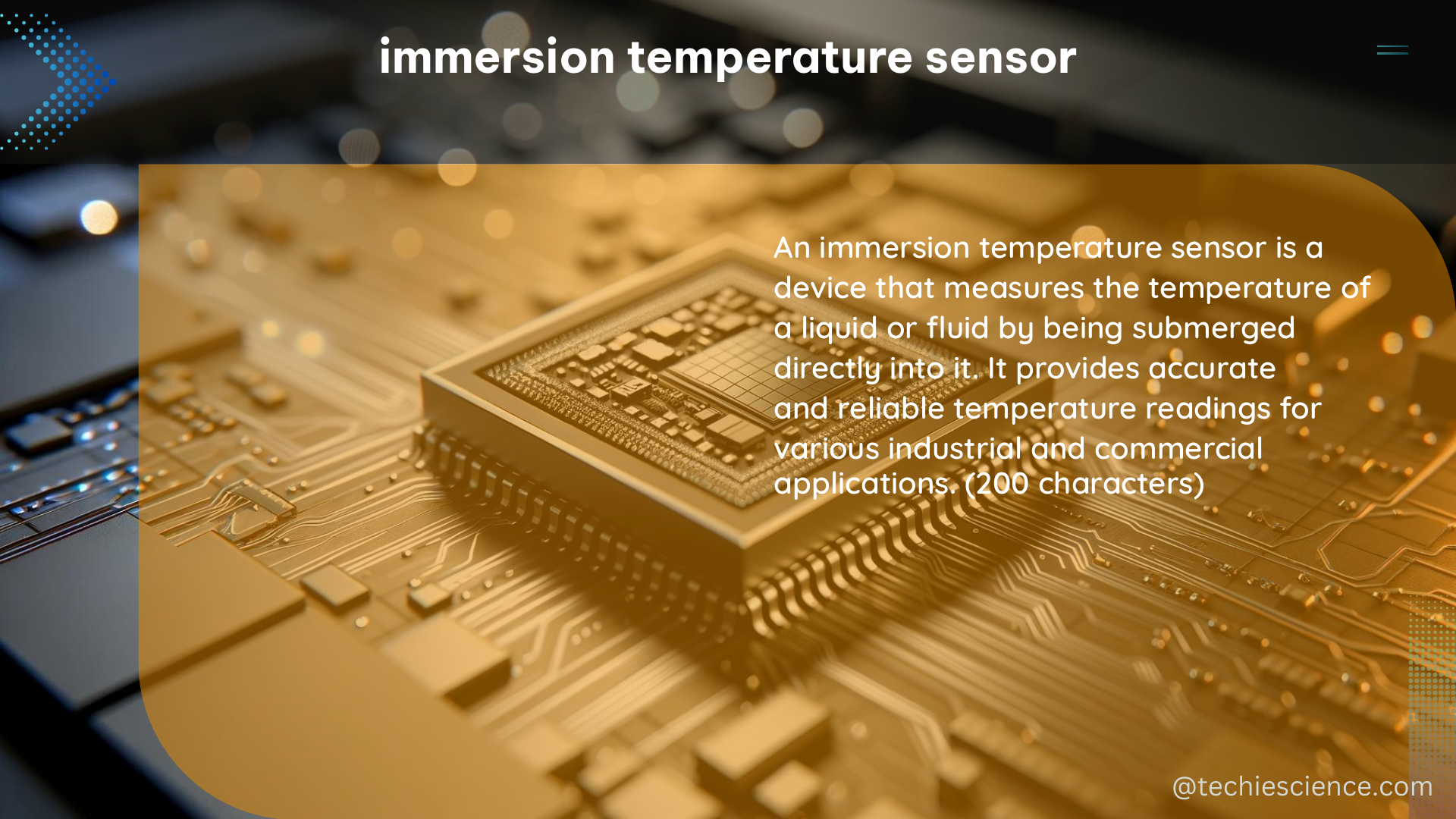An immersion temperature sensor, also known as an immersion probe or immersion well temperature sensor, is a critical device used to measure the temperature of fluids or gases in various industrial and commercial applications, including heating, ventilation, and air conditioning (HVAC) systems, chilled water plants, heating plants, and terminal units. These sensors play a crucial role in monitoring and controlling the temperature of these systems, ensuring optimal performance and energy efficiency.
Understanding Immersion Temperature Sensors
Immersion temperature sensors are designed to be submerged directly into the medium being measured, allowing for accurate and real-time temperature readings. These sensors are typically connected to a control system, such as a Building Automation System (BAS), which uses the temperature data to regulate and maintain the desired temperature conditions.
Technical Specifications of Immersion Temperature Sensors

The technical specifications of immersion temperature sensors can vary depending on the manufacturer and the specific application. However, some common specifications include:
Sensor Length
- Available lengths: 0.5mm, 2mm, or 0.2mm
- Longer sensor lengths are typically used for larger pipes or vessels, while shorter lengths are suitable for smaller-diameter applications.
Response Time
- Less than 3 seconds
- Faster response times allow for more accurate and responsive temperature monitoring and control.
Detection Limit/Range
- 1nM, 0.5nM, or 0.5pA/nM
- The detection limit and range of the sensor determine the minimum and maximum temperatures it can accurately measure.
Sensitivity
- 1~4pA/nM, 1~4pA/nM, or 0.5 pA/nM
- Sensor sensitivity refers to the change in output signal per unit change in temperature, with higher sensitivity providing more precise measurements.
Temperature-Dependent Output
- Immersion temperature sensors may have a temperature-dependent output, such as a voltage or current signal, that can be used by the control system to monitor and adjust the temperature.
Physiological Interference
- Immersion temperature sensors may be affected by physiological interference, such as the presence of certain chemicals or materials in the fluid or gas being measured.
Calibration and Maintenance of Immersion Temperature Sensors
Proper calibration of immersion temperature sensors is crucial for ensuring accurate temperature measurements. The Retro-Commissioning Process Manual recommends using a calibrated field meter to verify the accuracy of the sensor and making any necessary calibration adjustments within the margin of error of the sensing position of the calibrated meter.
In addition to calibration, it is also important to perform regular maintenance on immersion temperature sensors to ensure their continued reliability and accuracy. This may include:
- Cleaning the sensor tip to remove any buildup of deposits or contaminants
- Inspecting the sensor for any physical damage or wear
- Verifying the sensor’s electrical connections and signal output
- Replacing the sensor if it is found to be outside the acceptable calibration range
Other Sensors Used in HVAC Systems
In addition to immersion temperature sensors, HVAC systems commonly utilize a variety of other sensors to monitor and control various parameters, including:
| Sensor Type | Description |
|---|---|
| Air Temperature Sensors | Measure the temperature of the air in a specific location, such as a room or duct. |
| Return/Exhaust Air Temperature Sensors | Measure the temperature of the air being returned or exhausted from a space. |
| Return/Exhaust Air Humidity Sensors | Measure the humidity of the air being returned or exhausted from a space. |
| Mixed Air Temperature Sensors | Measure the temperature of the air mixture before it enters the air handling unit. |
| Preheat Air Temperature Sensors | Measure the temperature of the air before it enters the preheat coil. |
| Outside Air Temperature Sensors | Measure the temperature of the outdoor air. |
| Duct Static Pressure Sensors | Measure the static pressure within a duct system. |
| Zone Temperature Sensors | Measure the temperature of a specific zone or space. |
| Fan Speed Command Sensors | Measure the commanded speed of a fan. |
| Fan Start/Stop Sensors | Detect when a fan is started or stopped. |
| Fan Speed or Status Feedback Sensors | Provide feedback on the actual speed or status of a fan. |
| Damper Actuator Sensors | Provide feedback on the position of a damper actuator. |
| Valve Actuator Sensors | Provide feedback on the position of a valve actuator. |
When testing control sensors in HVAC systems, it is important to verify the proper location of the sensor, ensure that the sensor is in calibration, and verify the accuracy of the sensor signal scaling. Valve and damper actuators and linkages should also be physically inspected and operated through their full range to verify control functionality and operable condition.
Conclusion
Immersion temperature sensors are essential components in HVAC systems, chilled water plants, heating plants, and terminal units, providing critical temperature data for monitoring and control. Understanding the technical specifications, calibration requirements, and maintenance procedures for these sensors is crucial for ensuring the optimal performance and energy efficiency of these systems. By incorporating a comprehensive understanding of immersion temperature sensors and other HVAC sensors, facility managers and technicians can effectively maintain and optimize their building’s temperature control systems.
Reference:
- Retro-Commissioning Process Manual: https://www.cfm.va.gov/til/Cx-RCx/RetroCxManual.PDF
- Investigating the effectiveness of immersive VR skill training and its …: https://www.ncbi.nlm.nih.gov/pmc/articles/PMC9663202/
- TBR4100/1025 – World Precision Instruments: https://www.wpiinc.com/media/wysiwyg/pdf/TBR_IM.pdf

The lambdageeks.com Core SME Team is a group of experienced subject matter experts from diverse scientific and technical fields including Physics, Chemistry, Technology,Electronics & Electrical Engineering, Automotive, Mechanical Engineering. Our team collaborates to create high-quality, well-researched articles on a wide range of science and technology topics for the lambdageeks.com website.
All Our Senior SME are having more than 7 Years of experience in the respective fields . They are either Working Industry Professionals or assocaited With different Universities. Refer Our Authors Page to get to know About our Core SMEs.